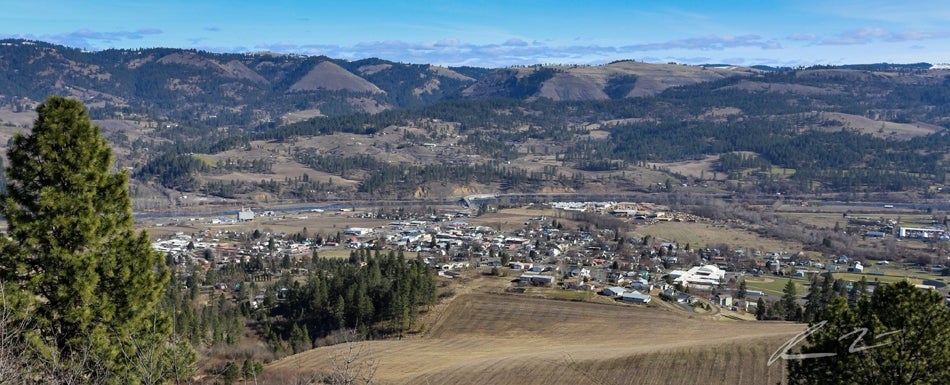Lead community-based resilience assessments and resilience strategies
Introduction

Annually, the U.S. spends billions of dollars recovering from disasters. Research shows that every $1 spent on mitigation saves $4-6 in post-disaster recovery, highlighting the need for pre-disaster research and mitigation.
Further, developing ways to measure resilience and build resilience strategies that reduce risk, enhance economic resilience, identify and prioritize infrastructure upgrades, and address the most pressing needs of our communities, is a national priority1-5.
However, rural communities typically lack the capacity and expertise to build collaborative resilience strategies, and most resilience metrics are designed for urban centers6.
In 2021, the HCRI and six students enrolled in the Building Resilience Communities VIP course piloted a resilience assessment approach that adapts the City Resilience Index6, designed for urban centers, for the rural City of Kamiah, ID. The team engaged cross-sector regional stakeholders and rights holders, including the Nez Perce Tribe, to conduct a resilience assessment for the City, which is located at the boundary of two counties and within the bounds of the Nez Perce Tribe Reservation.
To build the Kamiah Resilience Assessment, we convened 24 group interviews with a total of 42 participants (some participants were involved in multiple interviews), totaling more than 50 hours of interaction. The purpose of the group interviews was to bring together community members from across sectors and enhance community connections and collaborative potential.
The assessment considers acute shocks, such as natural and anthropogenic disasters, and chronic stressors, which are slow-evolving issues such as poverty, lack of economic resilience, housing, and food insecurity that weaken the fabric of a community over time.
We include the dimensions of infrastructure and environment, economy and society, leadership and strategy, and health and well-being. Fifty-two indicators evaluated through 156 indicator questions (both qualitative and quantitative) determined the community’s strengths and areas of need beneath each dimension.
Following the assessment, the HCRI team led a solutions-focused community workshop with 50 attendees to develop a resilience strategy roadmap. We shared our process, list of interviews and interviewees, and all results through a user-friendly the Kamiah Resilience Website.
This was accomplished over an 8-month period that included one semester of our VIP Building Resilient Communities course (Spring 2022).
Community-based resilience assessments and resilience strategies City of Kamiah Case Study
During fall of 2022 and continuing into spring 2023, we helped the City of Kamiah get started on their resilience strategy actions by connecting Boise State professors and students aligned with specific research projects through our ongoing VIP course. Research projects include:
1. Collaborative flood mitigation and shared decision-making through the Lawyer Creek Technical Working Group.
Faculty: Dr. Brittany Brand, Geosciences;
Student: Anujay Chopra (undergraduate), Communications
2. Lewis County Tax Revenue and Economic Resilience Assessment:
Faculty: Dr. Lee Parton, Economics;
Student: Tayah Brodt (undergraduate), Economics
3. Kamiah Infrastructure Asset Mapping and Upgrade Plan.
Faculty: Drs. Brittany Brand and Carson MacPherson-Krutsky, Geosciences;
Student: Sabrina Akther (graduate), Geosciences
4. Kamiah Housing Assessment and Improvement Plan.
Faculty: Drs. Brittany Brand and Vanessa Fry;
Student: Nathaniel Campbell (undergraduate), Urban Planning
Testimonials
“The work produced by the HCRI … far transcends any expectation the city could have hoped for and continues to this day. The body of work, analysis, and data compiled by the HCRI will serve the City of Kamiah into the next decade for decision-making and grant application purposes.” – Mike Tornatore, Deputy Clerk, City of Kamiah
“The HCRI is engaging the Kamiah community in resilience discussions and coordinating efforts to make lasting improvements for a safer Kamiah. Dr. Brand reached out to tribal, city, county, and community stakeholders for input on what is important gathered their vision, and provided professional presentations and data to inform decisions. HCRI provided an important service to get the ball rolling in a beautiful, underserved Idaho community”. – Susan Cleverley, Mitigation Section Chief, Idaho Office of Emergency Management
What is next?
- develop more relevant metrics for rural communities,
- research how to scale up this model for university-community partnerships, and
- create an interactive, web-based tool that compiles resilience assessment results and strategies into a user-friendly dashboard. This dashboard will help communities identify and track resilience projects
The HCRI executive team is working to update and expand this interdisciplinary, community-engaged, solutions-oriented, and student-centered opportunity to serve more communities in the future through our VIP Building Resilient Communities course. We are also creating a model for developing a robust university-community partnership-driven program for building resilience in communities of all sizes that can be adopted by universities in other states.
References Cited
- FEMA Building Resilient Infrastructure and Communities Program.
https://www.fema.gov/grants/mitigation/building-resilient-infrastructure-communities - National Academies of Sciences, Engineering, and Medicine. (2019).
Building and measuring community resilience: actions for communities and the Gulf Research Program. - National Academies of Sciences, Engineering, and Medicine. (2021).
Motivating Local Climate Adaptation and Strengthening Resilience: Making Local Data Trusted, Useful, and Used. - National Academies of Sciences, Engineering, and Medicine. (2021).
Enhancing Community Resilience through Social Capital and Social Connectedness: Stronger Together!. - Text – H.R.3684 – 117th Congress (2021-2022): Infrastructure Investment and Jobs Act. (2021, November 15).
https://www.congress.gov/bill/117th-congress/house-bill/3684/text - Index, C. R. (2014). City resilience framework. The Rockefeller Foundation and ARUP, 928.